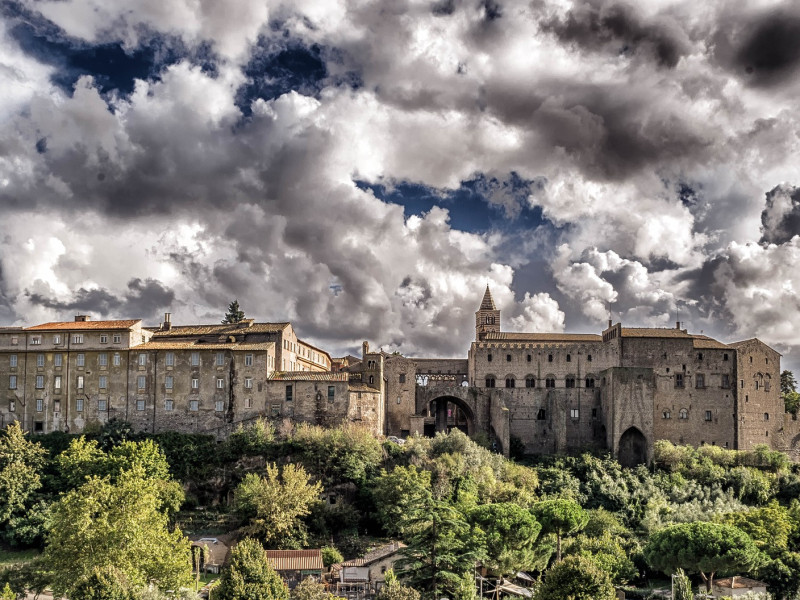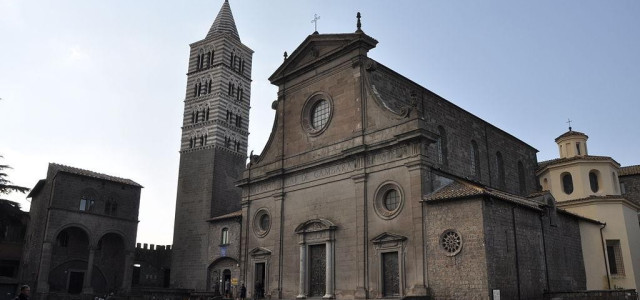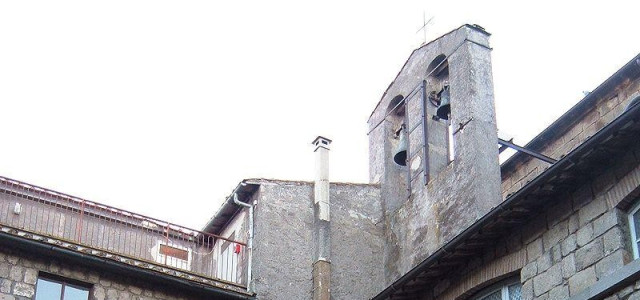Viterbo
See also Viterbo, Texas and Viterbo University Viterbo listen is an ancient city and comune in the Lazio region of central Italy, the capital of the province of Viterbo. It conquered and absorbed the neighboring town of Ferento in its early history. It is approximately 80 kilometres (50 miles) north of GRA (Rome) on the Via Cassia, and it is surrounded by the Monti Cimini and Monti Volsini. The historic center of the city is surrounded by medieval walls, still intact, built during the 11th and 12th centuries. Entrance to the walled center of the city is through ancient gates. Apart from agriculture, the main resources of Viterbo's area are pottery, marble, and wood. The town is home to the Italian gold reserves, an important Academy of Fine Arts, the University of Tuscia, and the Italian Army's Aviation Command headquarters and training centre. It is located in a wide thermal area, attracting many tourists from the whole of central Italy. History The first report of the new city dates to the eighth century CE, when it is identified as Castrum Viterbii. It was fortified in 773 by the Lombard King Desiderius in his vain attempt to conquer Rome. When the popes switched to the Frankish support, Viterbo became part of the Papal States, but this status was to be highly contested by the emperors in the following centuries, until in 1095 it is known it was a free comune. In a period in which the popes had difficulties asserting their authority over Rome, Viterbo became their favourite residence, beginning with Pope Eugene III (1145–1146) who was besieged in vain in the city walls. In 1164, Frederick Barbarossa made Viterbo the seat of his antipope Paschal III. Three years later he gave it the title of "city" and used its militias against Rome. In 1172, Viterbo started its expansion, destroying the old city of Ferentum and conquering other lands. In this age it was a rich and prosperous comune, one of the most important of Central Italy, with a population of almost 60,000. In 1207, Pope Innocent III held a council in the cathedral, but the city was later excommunicated as the favourite seat of the heretical Patarines and even defeated by the Romans. In 1210, however, Viterbo managed to defeat Emperor Otto IV and was again at war against Rome. In the thirteenth century it was ruled alternately by the tyrants of the Gatti and Di Vico families. Frederick II drew Viterbo to the Ghibelline side in 1240, but when the citizens expelled his turbulent German troops in 1243 he returned and besieged the city, but in vain. From that point Viterbo was always a loyal Guelph city. Between 1257 and 1261 it was the seat of Pope Alexander IV, who also died there. His successor Urban IV was elected in Viterbo. In 1266–1268, Clement IV chose Viterbo as the base of his ruthless fight against the Hohenstaufen. Here, from the loggia of the papal palace, he excommunicated the army of Conradin of Swabia which was passing on the Via Cassia, with the prophetical motto of the "lamb who is going to the sacrifice". Other popes elected in Viterbo were Gregory X (1271) and John XXI (1276) (who died in the papal palace when the ceiling of the recently built library collapsed on him while he slept), Nicholas III and the French Martin IV. The Viterbese, who did not agree with the election of a foreigner directed by the King of Naples, Charles I of Anjou, invaded the cathedral where the conclave was held, arresting two of the cardinals. They were subsequently excommunicated, and the popes avoided Viterbo for 86 years. Without the popes, the city fell into the hands of the Di Vicos. In the fourteenth century, Giovanni di Vico had created a seignory extending to Civitavecchia, Tarquinia, Bolsena, Orvieto, Todi, Narni and Amelia. His dominion was crushed by Cardinal Gil de Albornoz in 1354, sent by the Avignonese popes to recover the Papal States, who built the castle. In 1375, the city gave its keys to Francesco Di Vico, son of the previous tyrant, but thirteen years later the people killed him and assigned the city first to Pope Urban VI, and then to Giovanni di Sciarra di Vico, Francesco's cousin. But Pope Boniface IX's troops drove him away in 1396 and established a firm papal suzerainty over the city. The last Di Vico to hold power in Viterbo was Giacomo, who was defeated in 1431. Thenceforth Viterbo became a city of secondary importance, following the vicissitudes of the Papal States. In the 16th century it was the birthplace of Latino Latini. It became part of Italy in 1871. Coat of arms Viterbo has two heraldic badges in its coat of arms (stemma), the Lion and the Palm Tree. The lion represents Hercules, one of the mythological founders of Viterbo. The palm tree was added sometime in the Dark Ages (4th–9th century CE) when Viterbo conquered and absorbed the neighboring town of Ferento. The letters FAUL, often surround the badges. It is unclear what they refer to. Some suggest the four legendary Etruscan nobles families, believed to be involved in the founding of the city, while others claim that they are in reference to the four hills of Viterbo. Climate Viterbo experiences a border line humid subtropical climate (Köppen climate classification Cfa) and Mediterranean climate (Köppen climate classification Csa) as only one summer month is below the 40 mm precipitation limit. Main sights Viterbo's historic center is one of the best preserved medieval towns of central Italy. Many of the older buildings (particularly churches) are built on top of ancient ruins, recognizable by their large stones, 50 centimeters to a side. The main attraction of Viterbo is the papal palace, the (Palazzo dei Papi), that served as a country residence and a retreat in time of trouble in Rome. The columns of the palace are spolia from a Roman temple. The second most important monument of the city is the Cathedral of S. Lorenzo. It was erected in Romanesque style by Lombard architects over a temple of Hercules. It was variously rebuilt from the sixteenth century on, and was heavily damaged in 1944 by Allied bombs. The notable Gothic belfry is from the first half of the fourteenth century, and shows influence of Sienese artists. The church houses the sarcophagus of Pope John XXI and the picture Christ Blessing by Gerolamo da Cremona (1472). Other notable monuments are: The Palazzo Comunale (begun 1460), Palazzo del Podestà (1264) and Palazzo della Prefettura (rebuilt 1771) on the central square Piazza del Plebiscito. The Palazzo Comunale houses a series of sixteenth century and Baroque frescoes by Tarquinio Ligustri, Bartolomeo Cavarozzi and others. The small Gothic church of Santa Maria della Salute, which has a rich portal. The Romanesque Chiesa del Gesù (eleventh century). Here the sons of Simon de Montfort stabbed to death Henry of Almain, son of Richard of Cornwall. The Palazzo Farnese (fourteenth-fifteenth century), where Alessandro Farnese, the future Pope Paul III, lived in his youth together with his beautiful sister, Giulia Farnese. The Rocca (castle). The Romanesque churches of Santa Maria Nuova (twelfth century), San Sisto (second half of the ninth century), and San Giovanni in Zoccoli (eleventh century). The Palazzo degli Alessandri in the old district, a typical patrician house of Middle Ages Viterbo. The Fontana Grande, begun in 1206. The Gothic church of San Francesco, built over a pre-existing Lombard fortress. It has a single nave with a Latin cross plan. It houses the sepulchre of Pope Adrian V, who died in Viterbo on 17 August 1276, considered the first monument by Arnolfo di Cambio. The Museo Civico (City Museum) houses many archeological specimens from the pre-historic to Roman times, plus a Pinacoteca (gallery) with paintings of Sebastiano del Piombo, Antoniazzo Romano, Salvator Rosa, Antiveduto Grammatica and others. The Orto Botanico dell'Università della Tuscia is a botanical garden operated by the university. In the valley of the Arcione River just to the west of Viterbo are a number of springs celebrated for the healing qualities of their waters, and in use since Etruscan and Roman days. In fact, the imposing ruins of a great Roman bath are still to be seen and were drawn in plan and perspective by Renaissance masters, including Giuliano da Sangallo, Michelangelo, and Giorgio Vasari. One of most famous of these thermal springs was that known as the "Bulicame", or bubbling place, whose reputation had even reached the ears of the exiled poet Dante Aligheri. Canto 14 (lines 79–81) of Dante's Inferno describes how: Not far from the Bulicame whose waters, apparently, were always taken in the open, is the Bagno del Papa (Bath of the Pope). Almost totally concealed within the structure of a modern luxury spa hotel are the remains of a Renaissance bath palace that attracted the active attention of two popes. Actually, the origins of this bathing establishment go back to the Middle Ages when it was known as the Bagno della Crociata (so named either after a Crusader who supposedly discovered the spring or from a corruption of the Italian word for crutch). Early 15th-century documents provide a description of the medieval bath building that covered three distinct thermal springs all under one roof. This bath house was radically transformed by the first humanist pope of the Italian Renaissance, Nicholas V, who, c. 1454, ordered the construction of a bath palace to be built (according to Nicholas's biographer, Gianozzo Manetti) "with such magnificence and with such expense that it was not only deemed suitable for a stay and salutary for the sick but seemed an edifice destined to have rooms fit for princes and for living regally." A more precise description of just what Pope Nicholas ordered constructed is found in the writings of the Viterbese chronicler Nicola della Tuccia, who, in the 1470s, described the new Bagno del Papa as a battlemented building about 30 x 20 m in size with high towers at the corners of its southern façade. Its appearance would have been more fortress than watering place. Located outside Viterbo the thermal spa would have been an easy target for roving bands of bandits had the building not assumed a militant character, one which also affirmed papal authority in this region. Aside from the regal apartments described by Manedtti there were vaulted chambers at the lowest level to accommodate the patrons of the several thermal springs. Manetti, followed by Vasari, named the Florentine architect and sculptor Bernardo Rossellino as the person responsible for a series of building projects carried out throughout the Papal States at the orders of Pope Nicholas and his name is usually associated with the project in Viterbo. There is, however, no reason, either through documentation or architectural style, to connect Rossellino directly with the construction of the Bagno del Papa. To the contrary, Vatican payment records from 1454, preserved in the state archives in Rome, identify a stonemason from Lombardy, named Stefano di Beltrame, as the builder who "had done or was doing in the house ordered by the pope at the bagni della Grotta and Crociata of Viterbo." Construction work at the Bagno del Papa was continued on through the reigns of several popes who followed Nicholas V. The Vatican account books make mention of payments "for building done at the bath palace of Viterbo" during the reigns of Calixtus III, Paul II, and Sixtus IV. There also is strong evidence that Pope Pius II was responsible for the addition of a western wing to the building. Travelers' descriptions, etched views, and local guidebooks chronicle the fate of the Renaissance Bagno del Papa over the years and through several rebuildings resulting in a general assumption that most of the original 15th-century structure had vanished. A guide to Viterbo from 1911 does note that some remnants were still to be detected in basement piers and vaults. In operation as a thermal hospital in 1927, the building was blown up by retreating German forces in 1944. Despite all the rebuildings, the demolition attempt, post-war reconstruction and the latest modification as a resort destination, much of the original Bagno del Papa of Popes Nicholas V and Pius II survives, including the corner towers and the vaulted chambers where Renaissance patrons once bathed. The Villa Lante, an example of Mannerist gardening, is located in the frazione of Bagnaia. Education The city is home to the University of Tuscia, established in 1979. It is also the city where students of School Year Abroad's Italy program study, their school housed in a 16th-century palazzo on Via Cavour. Military Viterbo became a centre of military aviation due to its proximity to Rome, especially after the opening of the Air Force base (now the Rome Viterbo Airport but still used for military purposes) during the 1930s. The Army Aviation Command headquarters and training school (Italian: Scuola marescialli dell'Aeronautica Militare) are both located there. The Army's NCO training establishment (Italian: Scuola sottufficiali dell'Esercito Italiano) is also located in the city. Culture Patron saints St. Rose is the patron saint of Viterbo. The legend of Santa Rosa is that she helped to eradicate those few who supported the emperors instead of the popes, around 1250. Saint Lawrence is the male patron saint. Macchina di Santa Rosa The transport of the Macchina di Santa Rosa takes place every year, on 3 September, at 9 o'clock in the evening. The Macchina is an artistic illuminated bell-tower with an imposing height of 30 m. It weighs between 3.5 and 5 tonnes and is made of iron, wood and papier-mâché. At the top of the tower, the statue of the patron saint is enthusiastically acclaimed by the people in the streets of the town centre, where lights are turned off for the occasion. One hundred Viterbesi men (known as the Facchini) carry the Macchina from Porta Romana through each of the major streets of Viterbo to seven churches to be blessed, concluding with a strenuous ascension up to the Piazza di Santa Rosa, its final resting place. Each Macchina's lifespan differs, but contests for a new design are held every few years. Transportation The Rome Viterbo Airport was opened in 1936 as part of Viterbo Air Force Base, located 3 kilometres (2 miles) from the town. On 26 November 2007, Italian transport minister Alessandro Bianchi announced that Viterbo had been chosen as the site of the next airport in Lazio to serve Rome, over Latina, Frosinone, and Guidonia. Notable people Born Leonardo Bonucci, footballer Domenico Corvi, Neoclassicist painter Giuseppe Ottaviani, trance musician Saint Crispin (né Pietro Fioretti), member of the Friars Minor Capuchin Rose of Viterbo, patron saint of the city Lived in Viterbo Antonio del Massaro (also known as "Antonio da Viterbo"), painter Lorenzo da Viterbo, painter and activitist Reginald Pole, cardinal, archbishop of Canterbury, church reformer Notes Sources Charles R. Mack, "The Bath Palace of Nicholas V at Viterbo", in An Archiectural Progress in the Renaissance and the Baroque: Sojourns In and Out of Italy, Papers in Art History VIII, Pennsylvania State University, Vol. I, 1992, 45–63. Charles R. Mack, "The Renaissance Spa: Testing the Architectural Waters", Southeastern College Art Conference Review, XI, 3, 1988, 193–200. Valtieri, Simonetta, "Rinascimento a Viterbo: Bernardo Rossellino", Architettura, croniche e storia, XVII, 1972, 686–94. External links Official website, including a virtual tour of the city ViterboLive.it Tuscia 360 about Viterbo, including virtual tour featuring several VR panoramas Viterbo Tourist Promotion ViterboOnline.Com Festa delle Ciliegie (Cherry Festival and other information) SYA.org (School Year Abroad, a high-school study abroad program established in 1964, hosts an American school in Viterbo that accepts 11th- and 12th-grade applicants for one academic year.) Basket in Tuscia Basketball in Viterbo area Viterbo Video Guide Museo del Colle del Duomo (Pope palace) Pope palace, Museo del Colle del Duomo International Festival from July to September






